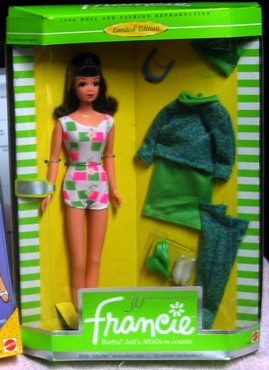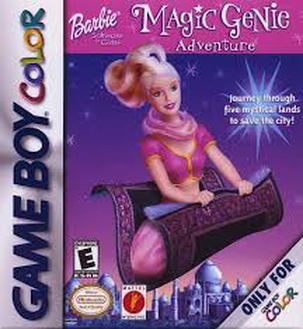
Mattel, Inc. is an American multinational toy manufacturing and entertainment company founded in Los Angeles by Harold Matson and the husband-and-wife duo of Ruth and Elliot Handler in January 1945 and headquartered in El Segundo, California. Mattel has a presence in 35 countries and territories; its products are sold in more than 150 countries. Mattel consists of three business segments: North America, International and American Girl.

Barbie is a fashion doll created by American businesswoman Ruth Handler, manufactured by American toy company Mattel and launched in 1959. The toy is the figurehead of the Barbie brand that includes a range of fashion dolls and accessories. Barbie has been an important part of the toy fashion doll market for over six decades. Mattel has sold over a billion Barbie dolls, making it the company's largest and most profitable line. The brand has expanded into a multimedia franchise since the late 1980s, including video games, computer-animated films, and a live-action film.

Kenneth Sean "Ken" Carson is a fashion doll introduced by American toy company Mattel in 1961 as the counterpart of Barbie, who had been introduced two years earlier.
Since Barbie's introduction as a teenage fashion model in 1959, the doll has been portrayed with many careers. Dolls are sold with sets of clothes and accessories that fit the career being portrayed. For example, the Lifeguard Barbie playset includes a Barbie, an outfit with shoes, a lifeguard chair, a dolphin, and a life preserver, while the Spanish Teacher Barbie includes a Barbie, an outfit with shoes, flashcards, a Spanish quiz, an easel, a notebook, a key chain, and a hairbrush.
Polly Pocket is a toy line of dolls and accessories first founded and designed by Chris Wiggs in 1983 and licensed by Bluebird Toys from 1989 until both entities/properties were acquired by Mattel in 1998.

Barbie is a multi-platform video game developed by Imagineering for Hi Tech Expressions. It is based on Mattel Inc.'s doll of the same name and was created in an attempt to get more girls to play video games. As such, it is one of the few explicitly girl-oriented NES games. The game takes place in a dream where Barbie must travel through three different worlds to gather accessories before attending a ball to meet Ken. Despite it having been of little interest to typical gamers at the time of its release, critics including staff writers for Velikij Drakon and Allgame have praised it as "not bad" for a generic platformer. Others including Justine Cassell and Nathanael Ng of the Georgia Institute of Technology have advanced the view that its genre is not appropriate for its content.

Gyarupronounced[ɡʲa̠ꜜɾɯ̟ᵝ], is a Japanese fashion subculture. The term gyaru is a Japanese transliteration of the English slang word gal.

Barbie: Super Model is a one or two-player educational action video game that allows the player to play as Barbie. It was released for the Sega Genesis, SNES and MS-DOS in 1993.

Love and Berry: Dress Up and Dance! is an arcade game and collectible card game from Sega, targeted toward girls. The game was first shown in amusement arcades on October 30, 2004, and became very popular among the target market in late 2005 through 2006. Game machines were installed in many department stores and children's play areas. Players receive 1 card at the start of the game with barcodes on them that stores information for new outfits, accessories, and hairstyles for the game characters. As of April 2006, there are 180 different collectible cards. As of January 2006, approximately 6,800 machines have been installed, and 104 million cards printed. It is the fourth trading card arcade game by Sega, following World Club Champion Football, Mushiking: The King of Beetles and The Key of Avalon.

Francie Fairchild is a fashion doll issued by Mattel from 1966 to 1976 and re-introduced in 2011. Marketed as "Barbie's MODern cousin" from England, the doll had an extensive line of "mod"-style clothing, often employing bright colors and geometric patterns similar to fashions associated with Carnaby Street in the late 1960s to early 1970s. At 11¼ inches tall, the Francie doll was shorter than Barbie, but taller than Skipper, making the character presumably between the two in age.
Earring Magic Ken, also known as "Gay Ken" and "Fey Ken", is a model of the Ken doll introduced by Mattel in 1993 as a companion to its Earring Magic Barbie figure, one of five dolls in the Earring Magic Barbie line.

Barbie Fashion Show: An Eye for Style is a strategy video game by Thai studio Cyber Planet Interactive based on the Barbie franchise. The game is the sequel to the PC game Barbie Fashion Show. In this game, players take the role of a fashion assistant to Barbie, voiced by Kelly Sheridan and her best friend, Teresa, voiced by Catherine 'Cat' Main. The game also allows players to design clothes to be worn by the models ingame.

Barbie and the Three Musketeers is a 2009 computer-animated fantasy film. It was released to DVD on September 15, 2009, and made its television premiere on Nickelodeon on November 22, 2009.

Style Savvy, known as Nintendo presents: Style Boutique in the PAL region and as Wagamama Fashion: Girls Mode in Japan, is a fashion video game developed by Syn Sophia and published by Nintendo. It was released for the Nintendo DS on October 23, 2008 in Japan, on October 23, 2009 in Europe, and November 2, 2009 in North America. The game is followed up by three sequels for the Nintendo 3DS called Style Savvy: Trendsetters, Style Savvy: Fashion Forward, and Style Savvy: Styling Star.

Mattel Interactive was a video game publisher and software distributor.

Barbie: Magic Genie Adventure is a single-player adventure/action game developed by Vicarious Visions and published by Mattel Interactive. It was released on the Game Boy Color on November 1, 2000.
Detective Barbie is a series of three mystery themed point and click adventure games starring the character Barbie. The series consists of Detective Barbie In the Mystery of the Carnival Caper! (1998) Detective Barbie 2: The Vacation Mystery (1999), and Detective Barbie: The Mystery Cruise (2000). The first two games were developed by Gorilla Systems Corporation and published on the PC by Mattel Media/Mattel Interactive. The third game was developed for the PlayStation by Runecraft.

Barbie Fashion Designer is a dress-up computer game developed by Digital Domain and published by Mattel Media for Microsoft Windows and Mac OS in 1996. The game allows players to design clothing and style outfits. Players can then print off their designs and create clothing for their real-world Barbie dolls. Barbie Fashion Designer was the first commercially successful video game made for girls. After its success, many other girl games would be made, leading to the girls' games movement.

Magic Fairy Tales: Barbie as Rapunzel is a 1997 educational adventure game developed by Media Station and published by Mattel Media.

Adventures with Barbie: Ocean Discovery is a 1997 video game developed by Gorilla Systems Corporation and published by Mattel Media for Windows. The Game Boy Color version is titled Barbie: Ocean Discovery.
















